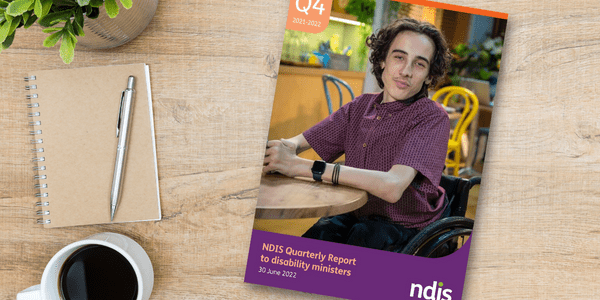
The National Disability Insurance Agency (NDIA) recently released its quarterly report, detailing its performance and operations from 1 April 2022 to 30 June 2022.
With the NDIS having been in operation for nine years, at over 800 pages the quarterly report contains a wide range of NDIS data, providing commentary about the Scheme’s progress, successes and challenges and providing insights on the Agency’s priorities.
According to the report, over the past three months the NDIA has been focusing on:
- Continued support for participants, providers, staff and partners during the COVID-19 pandemic including assisting with the vaccine roll-out, distribution of Rapid Antigen Tests (RAT) and delivery of National Workforce Support Services. At the end of July 2022, 6.8million RATs had been delivered to SIL providers.
- Supporting participants affected by floods. The NDIS National Contact Centre (NCC) received 23 flood-related calls from participants and providers during the June quarter requiring urgent support.
- The Co-design Advisory Group has continued to meet and provide valuable input into the NDIA’s co-design process. Over this quarter, the group was briefed by The Australian Centre for Social Impact (TACSI) on the NDIA’s progress with co-design and provided a roadmap moving forward.
- Implementing the NDIS legislation amendments that came into effect on 1 July 2022. You can read about these changes here.
- The Annual Pricing Review 2021-22 concluded over the last quarter. Click here to read more about the price updates that came into effect on 1 July 2022.
So, what did the quarter look like for participants and their plans?
The report shows a three per cent increase in total Participants, with 534,655 people with disability in the Scheme as of 30th June 2022. This represents an increase of 19,291 people since the last Quarterly Report, 44% of whom are aged between 0 and 6.
In recent years, considerable focus has been on Scheme Sustainability – with the cost of the Scheme significantly more than Government predictions and forecasts. The latest report shows that between 2021 and 2022, the average payment size only increased by 2%, from $54,300 to $55,200. ($39,500 for participants not in Supported Independent Living and $340,900 for participants in Supported Independent Living).
While payments have increased, plan budgets themselves have continued to drop in total value, indicative of Participants choosing to spend more of their allocated budget (also known as plan utilisation, which has increased by 2% between 2020-1 and 2021-22.
With today’s plans averaging $68,800, this continues the downward trend since 2019/20, when average plan budgets sat at $70,100. According to the Agency, rather than reducing Participant funding, this trend is due to changing demographics with more children accessing the scheme.
Limited growth in employment opportunities
The report states the NDIA are maintaining a strong focus on employment outcomes for NDIS participants but according to the figures much still needs to be done.
Of all the participants who are of working age (15 – 64) and who have been in the Scheme at least two years, only 23% are in paid work – a mere 1% increase from the previous year and only 1% higher than the 22% baseline. Good news is for people between 15-24, employment rates increased from 11% to 21%.
Reducing the number of AAT cases currently open
There has been considerable commentary regarding the number of Participants disputing funding decisions – a process that is emotionally taxing and costly for the Agency. The latest report gives us some insight on the current state of play, with 1,302 new proceedings launched to the Administrative Appeals Tribunal (AAT) last quarter – equal to almost 1% of all Participants. And while this figure has been trending downwards since December 2021, when 1.51% of Participants were disputing cases in the AAT, it is still considerably higher than two years ago, when just 0.39% of participants had active disputes.
What’s in store for the next Quarter?
Judging from the report’s introduction and details of the co-design committees, you can expect a lot more from the NDIA in this space.
One of the upcoming endeavours is the Information Gathering for Access and Planning (IGAP) project, which is responsible for delivering a new person-centred model of information gathering that delivers consistency and equity in access and planning outcomes.
Cyber Security also gets a mention, with the report stating the NDIA has embarked on a multi-year technology change agenda which incorporates a significant increase to the Agency’s cyber threat detection and prevention capabilities, as well as improving the understanding and management of ICT (Information and Communications Technology) Risk in NDIA.
The report also talks about the NDIA’s new ICT business system – PACE – which is being built to improve the end-to-end participant journey and planning process. PACE will replace the NDIA’s current CRM, portal and payment systems and, as outlined in the report, the NDIA is currently working with providers, including Civic, as well as Participants, in the design and build of the new system.
Click here to read the full report and access detailed data from the NDIA.


